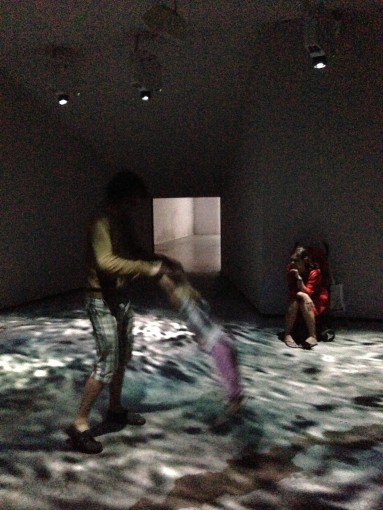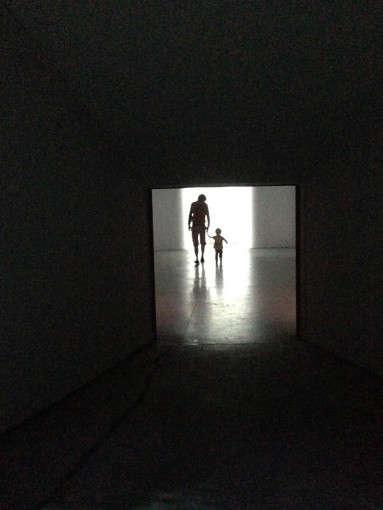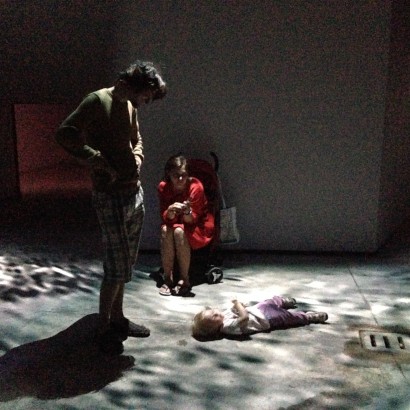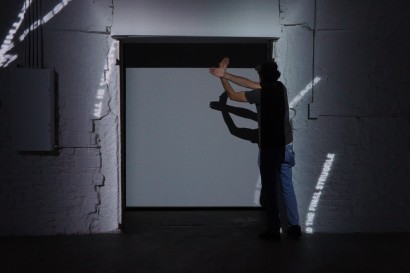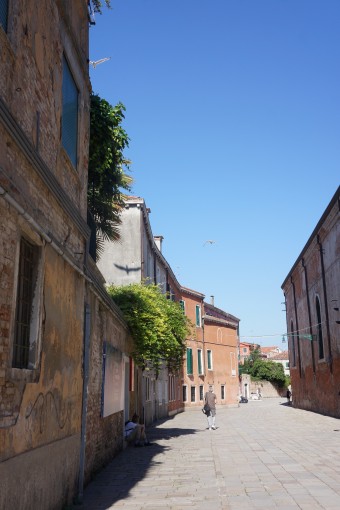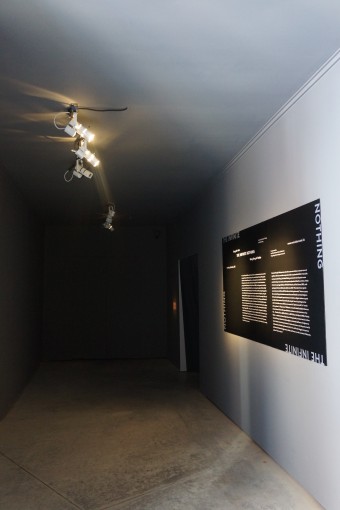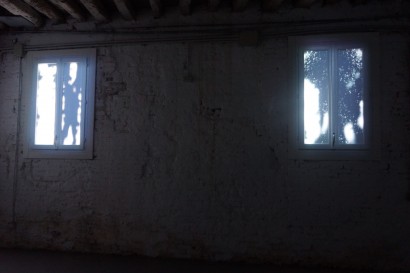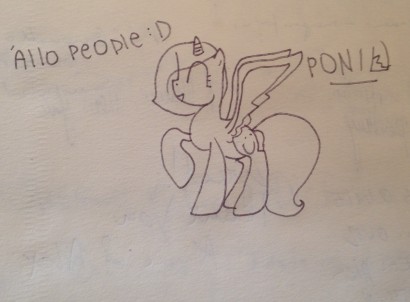How do you usually see an exhibition? Carefully read the curatorial statement before laying your eyes upon any artwork? Or go straight into the galleries without letting anything interfere with your first impression? Try to make sense of every piece? Or only care about those that grab your attention?
There can be a myriad of answers. I guess it also depends on your mood, how much time you have, who you are with as well as the type of the exhibition.
I have been working as an exhibition intern at The Infinite Nothing for only 2 weeks but I have already witnessed so many interesting ways of experiencing Tsang’s series of four video installations. Here are my favourites up till now.
你通常怎麼看展?是先細細品讀策展論述,還是徑直走向藝術品,自己解讀?是探索每一個角落,還是任直覺帶領你的目光?
每個人都有個特別的答案吧,也可能取決於心情,時間,同伴和展覽類型。
擔任《無盡虛無》的展覽實習生才兩個星期,已經見識了人們用各種奇特好玩的方式,體驗這分佈於四間房中的四組錄像裝置。在此和你們分享。
1. Run around for half an hour, leaving the tired mom resting on the stroller
A family with a kid in a stroller, which is not uncommon, entered the exhibition. Suddenly I heard a piercing scream. Did someone fall down due to the slippery floor? I rushed in, only to see a toddler running wild, cheering and screaming. Even funnier, while the dad still had the energy to play a bit with her, the mom was chilling on the stroller, watching them. I went back in 20 minutes and found the kid still dashing around. No wonder the mom looked so worn out.
一. 盡情玩耍,留媽媽在嬰兒車上休息
推著嬰兒車看展的家庭不少見,可這一家還挺特別。我當時坐在前台,突然聽到犀利的尖叫聲,就快步進入查看,結果見到了這樣一幕幕或搞笑或溫情的畫面。
二十分鐘後我再次查看時,見那孩兒不僅還在滿場奔跑尖叫,還開發了新動作,絕對是本展的忠實活力粉。有這樣的頑童,怪不得媽媽看起來累壞了。
2. Make hand shadows with parents and grandparents
This is the story of another family, a big one with children, parents and even grandparents. Just as they were about to exit the last room, they found their shadows on the wall that blocked their way out. So they decided to stop and make hand shadows all together. As asking for their permission to take a picture would have ruined the moment, I asked my colleague to reenact the scene for you;)
二. 和爸爸媽媽爺爺奶奶一起玩手影
我還見過一個四世同堂的大家庭。快要走出最後一間房時,他們發現錄像裝置的強光正好將自己的影子投在了出口處的白牆上,於是停下來,興致勃勃地玩起了手影。我不想掃興地跑過去詢問可否拍照,就讓我的同事扮演一次,方便大家想像吧;)
3. Take a peek and run away
A women took a peek at the entrance and turned back right away. ‘Oh I don’t like videos!’, she went. Choosing what to see based on the medium might be a practical way to survive the bombardment of art at a biennale with 89 national pavilions and 44 collateral events, I thought to myself. Another common reason for running away is that the exhibition space looks too dark. Especially on a typical Venetian summer day, the contrast between indoor and outdoor is simply too dramatic. However, this is exactly one of the central ideas of the exhibition – to turn day into night by constructing a huge box covering most part of the courtyard.
But wait, don’t run away as yet – perhaps it’s because you forgot you still have your sunglasses on!
(Several poor visitors went straight ahead, missing the entrance on the right side and bumping against the secret door of control room…)
三. 在門口瞄兩眼就閃
一個女人走進來,撥開幕布望了兩眼,蹬蹬地踩著高跟跑走了:「哦天,我可不喜歡錄像!」也是,今年的威尼斯雙年展有89個國家館,44個平行展,觀眾大都眼花撩亂甚至難負重荷了吧。也許只看自己最愛的媒介是一種實用的生存策略?
另一個比較常見的逃走原因就是展場實在太黑了。當典型的威尼斯夏日陽光填滿了門外的紅牆小巷,展場中的黑暗也許顯得不那麼親切。其實這正是藝術家曾建華的理念——通過嚴密的遮光結構和錄像裝置把這個帶庭院的居住空間徹底顛覆,化成黑夜,創造獨特的體驗。
不過話說回來,有時那些逃走的人連太陽眼鏡都沒摘呢!
4. Squat in the middle of the room and meditate
I showed a young man the way in and checked several minutes later, only to find him squatting in the middle of the projected river, deep in thoughts.
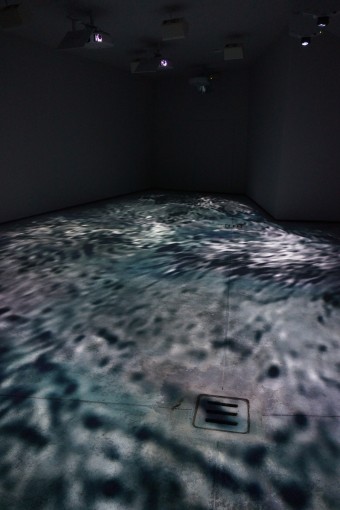 (I didn’t have the camera with me at that moment so please imagine for yourself:p)
(I didn’t have the camera with me at that moment so please imagine for yourself:p)
四. 蹲在房間中心冥想
雖然有的人覺得暗中冥想不是自己的菜,有位小伙可是非常享受。我見他久久蹲在第一間房的中心,望著身邊川流不息的河水影像,旁若無人地冥想。
(這個畫面也沒來得及捕捉下來,請自行腦補:p)
5. Explore every detail, and bump the head sometimes
Strict conservation rules and a common respect for historic structures in Venice means that altering existing architecture for the sake of exhibition is very difficult and rare. Most exhibition sites have preserved the characteristics of old residential apartments or historic houses, which makes them the opposite of ‘white cubes’. Therefore, knowing where the boundary of artworks lie can be very challenging sometimes.
I have already mentioned that in order to transform the space, the artist and curators of The Infinite Nothing had to take great pains to build a big box in the courtyard. In fact, the exhibition has also incorporated many existing architectural elements, including a narrow tunnel, two windows and three blind arches etc., giving them new symbolic meanings. For instance, in the third room, Tsang blacked out a pair of windows and projected onto it a video of dark, rainy scenes. It thus comes as no surprise when some visitors feel curious about every detail and explore around. But it really scared us when they bumped their head, opened the emergency door, or touched the windows to see if they were real!
五. 探索每個細節,偶爾撞到頭
出於對歷史痕跡的熱愛和對保育政策的尊重,威尼斯的許多當代藝術展場都很大程度地保留了建築原本的歷史特色和室內裝修,完全不同於當今流行的“白立方”。作為觀眾,有時真的很難分辨哪些是藝術品,哪些是原本的裝飾。
我之前提過,《無盡虛無》搭建了複雜的結構,改造了原有庭院。其實展覽也結合了許多原有的建築元素,特別是重新利用了三個盲拱、兩扇窗戶和狹窄的通道,賦予了它們新的象徵含義。比如在第三間房的《無盡虛無 - I》中,曾建華將兩扇窗戶封上,投射了貌似窗外雨景的錄像,真假難分。在這樣的環境中,好奇的觀眾難免會四處探索。不過橫衝直撞碰到頭,不小心打開緊急出口,又或是觸摸窗戶,可會把工作人員嚇壞的!
6. Draw a pony on the message book
A 11-year-old girl eagerly left a note on our message book after she came out. A pony – I saw her drawing. “This is inspired by the horse image in the exhibition, right?” “No no. It’s a pony. I love ponies!”
六. 在留言簿上畫匹小馬駒
一個十一歲的女孩走出展覽,熱切地想要留言。我看她畫的好像是馬,就問:「是因為看到了第二間房中馬的影像才畫馬的吧?」 「不是呀,這可是小馬駒。我最喜歡小馬駒了!」



